Qatar, a key mediator, has announced a four-day truce between Israel and the Palestinian group Hamas, bringing a temporary halt to the intense fighting that has plagued the region since October 7. The truce, set to commence at 7 am local time on Friday, has been eagerly awaited after weeks of relentless bombardment and worsening humanitarian conditions in Gaza.
When Does the Truce Begin?
The much-anticipated truce is scheduled to take effect at 7 am local time on Friday, according to Majed al-Ansari, a spokesperson for Qatar’s Foreign Ministry. This marks a crucial moment in the ongoing conflict, offering a brief respite from the hostilities that have left both sides grappling with the consequences of the prolonged strife.
What’s Included in the Deal?
The truce encompasses a multifaceted agreement involving the pause in fighting, the release of Hamas captives, and a reciprocal exchange of Palestinian prisoners held in Israeli prisons. Additionally, air traffic over northern Gaza will be halted during specific hours, while southern Gaza will experience a complete cessation during the truce.
How Will Hostages and Prisoners Be Released?
Over the four-day period, Hamas is set to release 50 women and children, among the 240 individuals captured during their assault on southern Israel. In return, Israel will release 150 Palestinian women and children, previously held in Israeli prisons. Israeli authorities have provided a list of approximately 300 Palestinian prisoners eligible for release, emphasizing that none have been accused of murder. The first batch of 39 Palestinian prisoners is expected to be released at 8 pm on Friday, contingent on the safe return of hostages from Gaza to Israeli soil. While this development has brought relief to some, it has also stirred despair for others, highlighting the complex emotions surrounding the conflict and its impact on the affected populations.
Armed Activity and the Path Forward
Addressing concerns about armed activity during the truce, Qatari negotiator Mohammed Al-Khulaifi affirmed that “no attack whatsoever” would occur. Hamas stated that Israel committed to suspending air traffic over specific areas and refraining from attacking or arresting anyone in Gaza. The truce also facilitates the movement of people along key routes and allows for the daily entry of aid trucks and fuel trucks into Gaza, providing a lifeline for civilians grappling with a severe humanitarian crisis. However, despite the optimism surrounding the truce, the question lingers: Is this the end of the fighting?
The international community, humanitarian organizations, and world leaders express hope that the truce could pave the way for a long-term ceasefire. Still, both Israel and Hamas remain resolute in their intent to continue the fight. Israeli Defense Minister Yoav Gallant foresees at least another two months of intense fighting, emphasizing that the current pause is but a brief respite.















